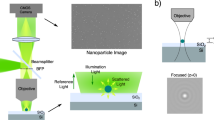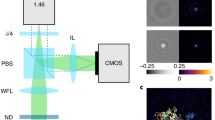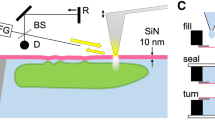Abstract
Label-free detection of the material composition of nanoparticles could be enabled by the quantification of the nanoparticles’ inherent dielectric response to an applied electric field. However, the sensitivity of dielectric nanoscale objects to geometric and non-local effects makes the dielectric response extremely weak. Here we show that electrostatic force microscopy with sub-piconewton resolution can resolve the dielectric constants of single dielectric nanoparticles without the need for any reference material, as well as distinguish nanoparticles that have an identical surface but different inner composition. We unambiguously identified unlabelled ~10 nm nanoparticles of similar morphology but different low-polarizable materials, and discriminated empty from DNA-containing virus capsids. Our approach should make the in situ characterization of nanoscale dielectrics and biological macromolecules possible.
This is a preview of subscription content, access via your institution
Access options
Subscribe to this journal
Receive 12 print issues and online access
$259.00 per year
only $21.58 per issue
Buy this article
- Purchase on Springer Link
- Instant access to full article PDF
Prices may be subject to local taxes which are calculated during checkout






Similar content being viewed by others
References
Balazs, A. C., Emrick, T. & Russell, T. P. Nanoparticle polymer composites: Where two small worlds meet. Science 314, 1107–1110 (2006).
Chen, H-Y., Lo, M. K. F., Yang, G., Monbouquette, H. G. & Yang, Y. Nanoparticle-assisted high photoconductive gain in composites of polymer and fullerene. Nature Nanotech. 3, 543–547 (2008).
Van Schooneveld, M. M. et al. Imaging and quantifying the morphology of an organic–inorganic nanoparticle at the sub-nanometre level. Nature Nanotech. 5, 538–544 (2010).
Alivisatos, P. The use of nanocrystals in biological detection. Nature Biotechnol. 22, 47–52 (2004).
Michalet, X. et al. Quantum dots for live cells, in vivo imaging, and diagnostics. Science 307, 538–544 (2008).
Davis, M. E., Chen, Z. & Shin, D. M. Nanoparticle therapeutics: An emerging treatment modality for cancer. Nature Rev. Drug. Discov. 7, 771–782 (2008).
Cao, Y. C., Jin, R. & Mirkin, C. A. Nanoparticles with Raman spectroscopic fingerprints for DNA and RNA detection. Science 297, 1536–1540 (2002).
Cvitkovic, A., Ocelic, N. & Hillenbrand, R. Material-specific infrared recognition of single sub-10 nm particles by substrate-enhanced scattering-type near-field microscopy. Nano Lett. 7, 3177–3181 (2007).
Stadler, J., Schmid, T. & Zenobi, R. Nanoscale chemical imaging using top-illumination tip-enhanced Raman spectroscopy. Nano Lett. 10, 4514–4520 (2010).
Zhu, J. et al. On-chip single nanoparticle detection and sizing by mode splitting in an ultrahigh-Q microresonator. Nature Photon. 4, 46–49 (2010).
Person, S., Deutsch, B., Mitra, A. & Novotny, L. Material-specific detection and classification of single nanoparticles. Nano Lett. 11, 257–261 (2011).
Huth, F., Schnell, M., Wittborn, J., Ocelic, N. & Hillenbrand, R. Infrared-spectroscopic nanoimaging with a thermal source. Nature Mater. 10, 352–356 (2011).
Frisbie, C. D., Rozsnyai, L. F., Noy, A., Wrighton, M. S. & Lieber, C. M. Functional group imaging by chemical force microscopy. Science 265, 2071–2074 (1994).
Stroh, C. et al. Single-molecule recognition imaging microscopy. Proc. Natl Acad. Sci. USA 101, 12503–12507 (2004).
García, R., Magerle, R. & Perez, R. Nanoscale compositional mapping with gentle forces. Nature Mater. 6, 405–411 (2007).
Sinensky, A. K. & Belcher, A. M. Label-free and high-resolution protein/DNA nanoarray analysis using Kelvin probe force microscopy. Nature Nanotech. 2, 653–659 (2007).
Sugimoto, Y. et al. Chemical identification of individual surface atoms by atomic force microscopy. Nature 446, 64–67 (2007).
Lee, D. T., Pelz, J. P. & Bhushan, B. Scanning capacitance microscopy for thin film measurements. Nanotechnology 17, 1484–1491 (2006).
Hu, J., Xiao, X. & Salmeron, M. Scanning polarization force microscopy: A technique for imaging liquids and weakly adsorbed layers. Appl. Phys. Lett. 67, 476–478 (1995).
Shao, R., Kalinin, S. V. & Bonnell, D. A. Local impedance imaging and spectroscopy of polycrystalline ZnO using contact atomic force microscopy. Appl. Phys. Lett. 82, 1869–1871 (2003).
Pingree, L. S. C. & Hersam, M. C. Bridge-enhanced nanoscale impedance microscopy. Appl. Phys. Lett. 87, 233117 (2005).
Pingree, L. S. C., Russell, M. T., Scott, B. J., Marks, T. J. & Hersam, M. C. Probing individual nanoscale organic light-emitting diodes with atomic force electroluminescence microscopy and bridge-enhanced nanoscale impedance microscopy. Org. Electr. 8, 465–479 (2007).
Kathan-Galipeau, K. et al. Direct probe of molecular polarization in de novo protein electrode interfaces. ACS Nano 5, 4835–4842 (2011).
Lai, K. et al. Nanoscale electronic inhomogeneity in In2Se3 nanoribbons revealed by microwave impedance microscopy. Nano Lett. 9, 1265–1269 (2009).
Fumagalli, L., Ferrari, G., Sampietro, M. & Gomila, G. Dielectric-constant measurement of thin insulating films at low frequency by nanoscale capacitance microscopy. Appl. Phys. Lett. 91, 243110 (2007).
Gomila, G., Toset, J. & Fumagalli, L. Nanoscale capacitance microscopy of thin dielectric films. J. Appl. Phys. 104, 024315 (2008).
Fumagalli, L., Ferrari, G., Sampietro, M. & Gomila, G. Quantitative nanoscale dielectric microscopy of single-layer supported biomembranes. Nano Lett. 9, 1604–1608 (2009).
Gramse, G., Casuso, I., Toset, J., Fumagalli, L. & Gomila, G. Quantitative dielectric constant measurement of thin films by DC electrostatic force microscopy. Nanotechnology 20, 395702 (2009).
Fumagalli, L., Gramse, G., Esteban-Ferrer, D., Edwards, M. A. & Gomila, G. Quantifying the dielectric constant of thick insulators using electrostatic force microscopy. Appl. Phys. Lett 96, 183107 (2010).
Cherniavskaya, O., Chen, L., Weng, L., Yuditsky, L. & Brus, L-E. Quantitative noncontact electrostatic force imaging of nanocrystal polarizability. J. Phys. Chem. B 107, 1525–1531 (2003).
Ben-Porat, C. H., Cherniavskaya, O., Brus, L., Cho, K-S. & Murray, C. B. Electric fields on oxidized silicon surfaces: Static polarization of PbSe nanocrystals. J. Phys. Chem. A 108, 7814–7819 (2004).
Bockrath, M. et al. Scanned conductance microscopy of carbon nanotubes and λ-DNA. Nano Lett. 2, 187–190 (2002).
Lu, W., Wang, D. & Chen, L. Near-static dielectric polarization of individual carbon nanotubes. Nano Lett. 7, 2729–2733 (2007).
Lu, W. et al. A scanning probe microscopy based assay for single-walled carbon nanotube metallicity. Nano Lett. 9, 1668–1672 (2009).
Agirrezabala, X. et al. Maturation of phage T7 involves structural modification of both shell and inner core components. EMBO J. 24, 3820–3829 (2005).
Ionel, A. et al. Molecular rearrangements involved in the capsid shell maturation of bacteriophage T7. J. Biol. Chem. 286, 234–242 (2011).
Carrasco, C. et al. The capillarity of nanometric water menisci confinedinside closed-geometry viral cages. Proc. Natl Acad. Sci. USA 106, 5475–5480 (2009).
Giordano, S. Dielectric and elastic characterization of nonlinear heterogeneous materials. Materials 2, 1417–1479 (2009).
Harvey, S. C. & Hoekstra, P. Dielectric relaxation spectra of adsorbed water on lyzozyme. J. Phys. Chem. 76, 2987–2994 (1972).
Gascoyne, P. & Pethig, R. Effective dipole moment of protein-bound water. J. Chem. Soc. Faraday Trans. 77, 1733–1735 (1981).
Schutz, C. N. & Warshel, A. What are the dielectric constants of proteins and how to validate electrostatic models? Proteins 44, 400–417 (2001).
Yang, L., Weerasinghe, S., Smith, P. E. & Pettitt, P. M. Dielectric response of triplex DNA in ionic solution from simulations. Biophys. J. 69, 1519–1527 (1995).
Cohen, H. et al. Polarizability of G4-DNA observed by electrostatic force microscopy measurements. Nano Lett. 7, 981–986 (2007).
Gomez-Navarro, C. et al. Contactless experiments on individual DNA molecules show no evidence for molecular wire behaviour. Proc. Natl Acad. Sci. USA 99, 8484–8487 (2002).
Jin, R. & Breslauer, K. J. Characterization of the minor groove environment in a drug-DNA complex: bisbenzimide bound to the poly[d(AT)]poly[d(AT)]duplex. Proc. Natl Acad. Sci. USA 85, 8939–8942 (1988).
Barawkar, D. A. & Ganesh, K. N. Fluorescent d(CGCGAATTCGCG): Characterization of major groove polarity and study of minor groove interactions through a major groove semantophore conjugate. Nucl. Acids Res. 23, 159–164 (1995).
Williams, L. R. & Maher, L. J. III Electrostatic mechanisms of DNA deformation. Annu. Rev. Biophys. Biomol. Struct. 29, 497–521 (2000).
Lamm, G. & Pack, G. R. Calculation of dielectric constants near polyelectrolytes in solution. J. Phys. Chem. 101, 959–965 (1997).
Young, M. A., Jayaram, B. & Beveridge, D. L. Local dielectric environment of B-DNA in solution: Results from a 14 ns molecular dynamics trajectory. J. Phys. Chem. B 102, 7666–7669 (1998).
He, L., Ozdemir, S. K., Zhu, J., Kim, W. & Yang, L. Detecting single viruses and nanoparticles using whispering gallery microlasers. Nature Nanotech. 6, 428–432 (2011).
Fraikin, J-L. et al. A high-throughput label-free nanoparticle analyser. Nature Nanotech. 6, 308–313 (2011).
Daaboul, G. G. et al. High-throughput detection and sizing of individual low-index nanoparticles and viruses for pathogen identification. Nano Lett. 10, 4727–4731 (2010).
Gomez-Monivas, S., Froufe-Perez, L. S., Caamano, A. & Saenz, J. J. Electrostatic forces between sharp tips and metallic and dielectric samples. Appl. Phys. Lett. 79, 4048–4050 (2001).
Horcas, I. et al. WSXM: A software for scanning probe microscopy and a tool for nanotechnology. Rev. Sci. Instrum. 78, 013705 (2007).
Sambrook, J, Fritsch, E. F. & Maniatis, T. Molecular Cloning: A Laboratory Manual (Cold Spring Harbour Laboratory Press, 1989).
Acknowledgements
The authors thank Nanotec Electronica for technical assistance, G. Gramse, M. A. Edwards and E. Torrents for discussions, and D. Normanno for comments on the manuscript. This work was supported by the Spanish MEC under grants TEC2010-16844 and BFU2011-29038-C02-1, by the Comunidad de Madrid grant S-2009/MAT-1507, and by the EU commission under grant FP7-NMP 228685-2. G.G. acknowledges support from a grant of the Spanish–Catalan I3 Program.
Author information
Authors and Affiliations
Contributions
L.F. did the experiments, performed the data analysis and wrote the paper. G.G. did the theoretical modelling and helped write the paper. D.E-F. implemented the finite-element calculations. A.C. prepared the viruses and performed electron microscopy and composition analysis of them. L.F. and G.G. designed the study with J.L.C. All the authors discussed the results and commented on the manuscript.
Corresponding author
Ethics declarations
Competing interests
The authors declare no competing financial interests.
Supplementary information
Supplementary Information
Supplementary Information (PDF 1506 kb)
Rights and permissions
About this article
Cite this article
Fumagalli, L., Esteban-Ferrer, D., Cuervo, A. et al. Label-free identification of single dielectric nanoparticles and viruses with ultraweak polarization forces. Nature Mater 11, 808–816 (2012). https://doi.org/10.1038/nmat3369
Received:
Accepted:
Published:
Issue Date:
DOI: https://doi.org/10.1038/nmat3369
This article is cited by
-
Dielectric properties and lamellarity of single liposomes measured by in-liquid scanning dielectric microscopy
Journal of Nanobiotechnology (2021)
-
Charge-polarized interfacial superlattices in marginally twisted hexagonal boron nitride
Nature Communications (2021)
-
Efficient long-range conduction in cable bacteria through nickel protein wires
Nature Communications (2021)
-
Sizing single nanoscale objects from polarization forces
Scientific Reports (2019)
-
Microwave measurement of giant unilamellar vesicles in aqueous solution
Scientific Reports (2018)



